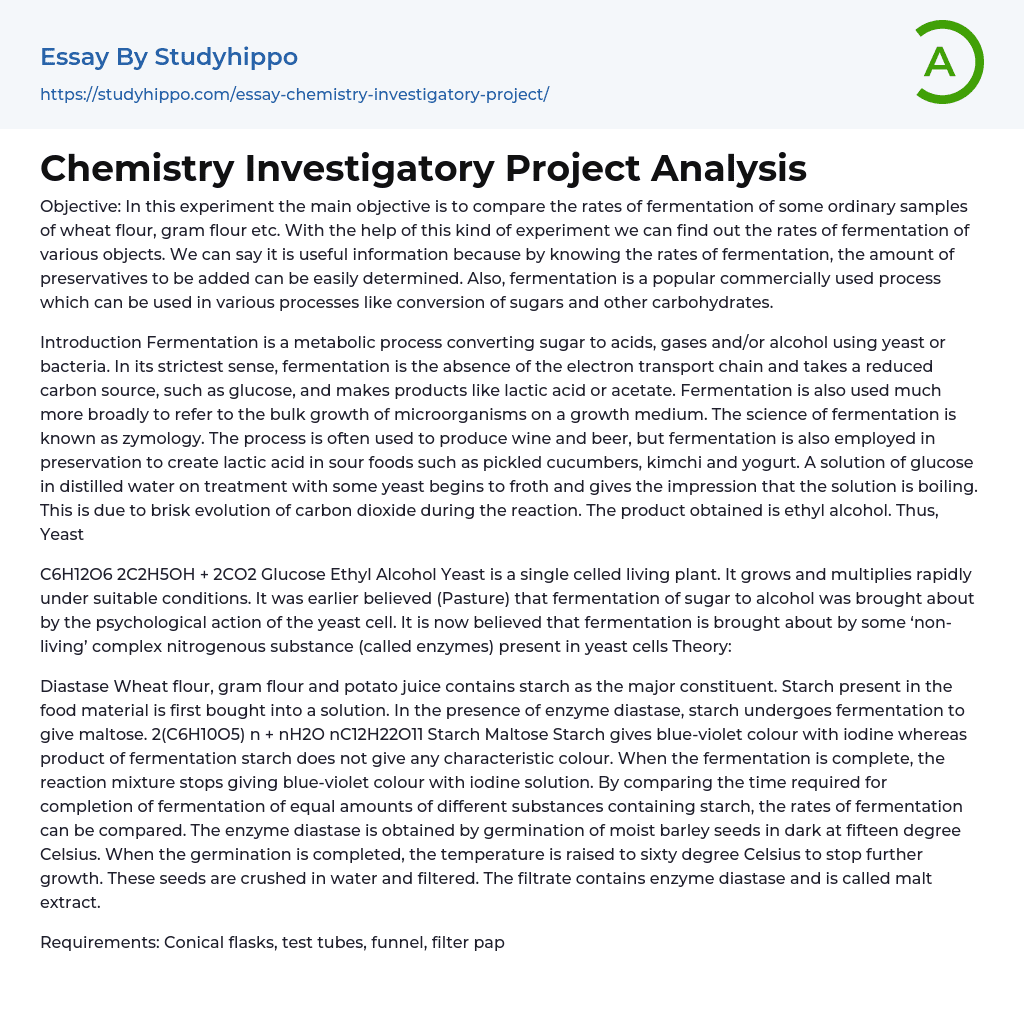The objective of this experiment is to compare the rates of fermentation of different samples such as wheat flour and gram flour. By conducting this experiment, we can determine the rates of fermentation for various objects. This information is useful as it helps in determining the appropriate amount of preservatives to be added. Fermentation is a widely used process in commercial applications, including the conversion of sugars and other carbohydrates.
Introduction
Fermentation is a metabolic process that converts sugar into acids, gases, and/or alcohol using yeast or bacteria. It involves the absence of the electron transport chain and utilizes a reduced carbon source, like glucose, to produce substances such as lactic acid or acetate. Fermentation is also employed in the broad context of microorganism growth on a growth medium. The scientif
ic field studying fermentation is called zymology. This process is commonly utilized in the production of wine and beer. However, fermentation is also used for preservation purposes, resulting in the formation of lactic acid in sour foods like pickled cucumbers, kimchi, and yogurt. To illustrate, when a solution of glucose in distilled water is treated with yeast, it starts foaming and gives the appearance of boiling due to the vigorous release of carbon dioxide. The end product obtained is ethyl alcohol. Hence, yeast plays a crucial role in fermentation.
C6H12O6 is transformed into 2C2H5OH + 2CO2 in a process called fermentation. This process is carried out by yeast, which is a single celled living plant. Under appropriate conditions, yeast grows and reproduces quickly. Initially, it was thought that the conversion of sugar into alcohol was a result of the psychological action
of yeast cells according to Pasteur's theory. However, it is now understood that fermentation occurs due to the presence of 'non-living' complex nitrogenous substances known as enzymes within the yeast cells.
The major constituent of Diastase Wheat flour, gram flour, and potato juice is starch. Starch in the food material is first dissolved in a solution. In the presence of the enzyme diastase, starch undergoes fermentation to produce maltose. Starch is converted to maltose according to the equation 2(C6H10O5) n + nH2O > nC12H22O11. Starch reacts with iodine to give a blue-violet color, but the product of fermentation starch does not show any characteristic color. Completion of fermentation is indicated by the reaction mixture no longer giving a blue-violet color with iodine solution. By comparing the time it takes for different substances with equal amounts of starch to complete fermentation, it is possible to compare the rates of fermentation. The diastase enzyme is obtained by germinating moist barley seeds in darkness at fifteen degrees Celsius. Once germination is complete, the temperature is raised to sixty degrees Celsius to stop further growth. These seeds are crushed in water and filtered to obtain a solution containing the diastase enzyme, which is known as malt extract.
The materials needed include conical flasks, test tubes, funnel, filter paper, water bath, wheat flour, gram flour, rice flour, potatoes, and 1% iodine solution.
Procedure: 1. In a 100 ml conical flask, take 5.0 g of wheat flour and add 30 ml of distilled water. 2. Boil the contents of the flask for approximately 5 minutes. 3. After cooling, filter the mixture to obtain wheat flour extract. 4. Add 5 ml
of 1% aq. NaCl solution to the wheat flour extract in a conical flask. 5. Place the flask in a water bath at a temperature of 50-60 degrees Celsius and add 2 ml of malt extract. 6. Take 2 drops of the reaction mixture after 2 minutes and mix with diluted iodine solution to observe the color produced. 7. Repeat this step every 2 minutes until no bluish color is observed, indicating completion of fermentation. Record the total time taken for fermentation to complete. 8. Repeat the experiment using extracts from gram flour, rice flour, and potato, and note the observations.
- Brewery essays
- Brewing essays
- Acid essays
- Calcium essays
- Carbohydrate essays
- Carbon essays
- Chemical Bond essays
- Chemical Reaction essays
- Chemical reactions essays
- Chromatography essays
- Concentration essays
- Copper essays
- Diffusion essays
- Ethanol essays
- Hydrogen essays
- Organic Chemistry essays
- Osmosis essays
- Periodic Table essays
- Ph essays
- Salt essays
- Sodium essays
- Titration essays
- Coaching essays
- Critical Thinking essays
- homework essays
- Learning essays
- Library essays
- Listening essays
- Literacy essays
- Mentor essays
- Physical Education essays
- Project essays
- Reading essays
- Research essays
- Sex Education essays
- Social Studies essays
- Standardized Testing essays
- Study Plan essays
- Teaching essays




